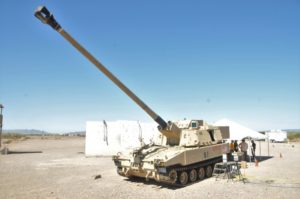As the Army looks to begin assessing industry’s offerings for its new effort to extend the range of its cannon artillery, the service’s secretary has said the aim is to select a capability in fiscal year 2025 to take into production.
Army Secretary Christine Wormuth on Wednesday detailed the new approach to getting after the requirement following the cancellation of the Extended Range Cannon Artillery (ERCA) future howitzer development effort, noting the service will hold a “performance demo” this summer with industry’s existing solutions.

“There are other platforms that we think could potentially meet our needs. So we are going to have a bunch of folks who have capabilities that they think might be useful and we expect we will probably select one of those for production in FY ‘25,” Wormuth said during a House Appropriations Defense Subcommittee hearing.
The Army confirmed last month it was ending the ERCA development effort, which had focused around integrating an Army-developed 58-caliber, 30-foot gun tube on BAE Systems’ M109A7 self-propelled howitzer chassis with an aim to develop a system capable of hitting targets out to 70 kilometers at a rate of six to 10 rounds per minute (Defense Daily, March 12).
Army officials had previously discussed engineering challenges with the ERCA development effort, to include excessive wear on the gun tube, which had delayed the planned timeline for the program.
Gen. Randy George, the Army chief of staff, added during Wednesday’s hearing that the challenge with ERCA “was basically the technology not being ready.”
“The requirement to have long-range fires…has not changed. I do think that the battlefield is changing. I do think that technology is changing. One of the things that we really need to focus on, this gets back to the cost curve as well, is how do we adjust the round? How do we adjust the missile? What are the things that we can do, I think, to increase performance? But long-range fires is critically important,” George told the panel.
George’s remarks echo similar comments from Army officials over the last month that the recent Tactical Fires Study informed the decision to end ERCA while reaffirming the requirement, with the Army now pivoting away from a development system and look at industry’s more existing, more mature capabilities.
BAE Systems has told Defense Daily it would be participating in the industry day for the post-ERCA effort said there’s interest in pursuing the requirement as it assesses the service’s new approach, with the company potentially looking to offer capabilities such as the M109-52 self-propelled howitzer that utilizes Rheinmetall’s L52 155mm, 52-caliber cannon or the Archer mobile artillery system, if the Army goes in a wheeled howitzer direction (Defense Daily, April 2).
“It’s pretty obvious to me that we’re going to have to look at it pretty hard. And the reason I say that is [because] every howitzer the U.S. Army owns, we build it. We feel like this is kind of our space, so it’s going to be important to understand what the Army wants and make sure that we have a way to compete in that space. So, certainly inside the business it’s a pretty important focus area for us,” Jim Miller, BAE Systems’ vice president of business development for combat mission systems, said during an interview at AUSA’s Global Force Symposium in Huntsville, Alabama.
In response to a question on lessons learned from the ERCA development effort, Wormuth told lawmakers on Wednesday the Army sees increasing value in using recently granted authorities from Congress to “off-ramp” from modernization efforts that are not working earlier in the process.
“One of the lessons, frankly, coming out of our experience with ERCA, which we will apply going forward to all of our modernization programs, is we need to have more points where we can have off-ramps if we see that a system isn’t working. Because, I think, we probably, if we had to do it over again, would have off-ramped away from ERCA a little bit sooner,” Wormuth said.